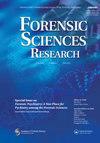Comparison of Derivatization Methods for Groomed Latent Print Residues Analysis via Gas Chromatography
IF 1.4
4区 医学
Q3 MEDICINE, LEGAL
引用次数: 1
Abstract
The practice of latent print analysis is comprised of a visual examination and the comparison of the fingerprint pattern from a questioned print to an exemplar(s). When a questioned print is either smudged or contains little pattern detail, the print comparison would be considered an inconclusive determination. However, in these scenarios, the latent print residues (LPRs) could provide associative information to supplement the current ACE-V (Analysis, Comparison, Examination-Verification) process. Advancements using analytical techniques allow for the analysis of LPR chemistry; however, derivatization is generally required to increase the abundance of components not traditionally observed in gas chromatography. This study aimed to determine whether two derivatization reagents, boron trifluoride in methanol (BF3-MeOH) and N-methyl-N-(trimethylsilyl)trifluoroacetamide (MSTFA), provide a better recovery of LPR components from a porous or non-porous substrate. Five volunteers deposited groomed latent print samples onto two substrates: a microfiber filter (porous) and a microscope slide (non-porous). The residues were derivatized or evaporated prior to the gas chromatography-mass spectrometry (GC-MS) analysis. The percent recoveries were higher, >83%, in the DCM extracted samples for both substrates compared to those samples prepared in hexanes. DCM/MSTFA derivatization provided the recovery of fatty acids that ranged from 20 to 30% for both substrates and a recovery of squalene at a rate of 2.37% for the filter sample and 4.2% for the slide sample. These rates were higher than the recovery rates obtained for the hexanes/BF3-MeOH-derivatized samples, with a range of 1–8% for the fatty acids recovery rates and 0.6–0.85% for squalene from both substrates. Overall, the MSTFA derivatization reagent produced higher recoveries for LPR on porous and non-porous substrates while providing a LPR chromatographic profile similar to that of a non-derivatized sample. The use of DCM as a solvent provided a wider range of LPR components recovered than hexanes and, thus, should be used as the extraction solvent when derivatizing samples, regardless of the substrate.气相色谱分析修饰潜印残留物衍生化方法的比较
潜在指纹分析的实践包括视觉检查和从被质疑的指纹到样本的指纹模式的比较。当被质疑的指纹被弄脏或包含很少的图案细节时,指纹比较将被认为是一个不确定的决定。然而,在这些情况下,潜印残留物(LPRs)可以提供关联信息,以补充当前的ACE-V(分析,比较,检验-验证)流程。分析技术的进步使LPR化学分析成为可能;然而,衍生化通常需要增加传统气相色谱中未观察到的组分的丰度。本研究旨在确定两种衍生化试剂,甲醇中的三氟化硼(BF3-MeOH)和n-甲基- n-(三甲基硅基)三氟乙酰胺(MSTFA)是否能更好地从多孔或非多孔底物中回收LPR成分。五名志愿者将整理好的潜在指纹样本放在两种基质上:微纤维过滤器(多孔)和显微镜载玻片(无多孔)。在气相色谱-质谱(GC-MS)分析之前,将残留物衍生化或蒸发。两种底物中DCM提取的样品的回收率均高于己烷制备的样品,回收率约为83%。DCM/MSTFA衍生化对两种底物的脂肪酸回收率均在20 - 30%之间,过滤样品的角鲨烯回收率为2.37%,载玻片样品的角鲨烯回收率为4.2%。这些回收率高于己烷/ bf3 -甲醇衍生样品的回收率,从两种底物中提取的脂肪酸回收率为1-8%,角鲨烯回收率为0.6-0.85%。总的来说,MSTFA衍生化试剂在多孔和非多孔底物上对LPR的回收率更高,同时提供了与非衍生化样品相似的LPR色谱图谱。与己烷相比,使用DCM作为溶剂可以回收更广泛的LPR成分,因此,在衍生化样品时,无论底物是什么,都应使用DCM作为提取溶剂。
本文章由计算机程序翻译,如有差异,请以英文原文为准。
求助全文
约1分钟内获得全文
求助全文

 求助内容:
求助内容: 应助结果提醒方式:
应助结果提醒方式:


